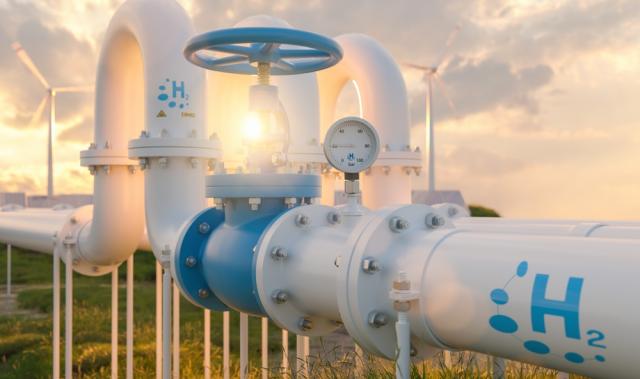
DNV's H2Pipe project is developing a new standard code for offshore hydrogen pipelines, addressing safety and cost-efficiency concerns for the transportation of pure hydrogen and as an additive to natural gas. (Source: Shutterstock)
DNV is launching the second phase of its joint industry project H2Pipe to develop a new standard code for offshore hydrogen pipelines, DNV announced on Feb. 20 in a press release.
H2Pipe addresses safety and cost-efficiency concerns for the transportation of pure hydrogen and as an additive to natural gas.
The company predicts in its Hydrogen Forecast to 2050 that over 50% of hydrogen pipelines globally will be repurposed from natural gas pipeline networks already existing, which will cost less than 35% to build new, said DNV in the press release. DNV’s H2Pipe project is developing a standard for design and infrastructure assessments for hydrogen pipelines, as well as safety and pipeline integrity targets for an increased use of hydrogen in existing pipelines.
In 2021, DNV’s first phase of H2Pipe began, which looked into the degradation of steel pipe mechanical properties in order to prepare for Phase 2.
Phase 2 will involve an experimental test program and will begin in March 2023 and last two years. It will test hydrogen embrittlement mechanisms and the effects of hydrogen on the integrity of line pipe material, as well as include a feasibility level design of offshore hydrogen pipelines and a risk assessment study for safety. DNV will use Phase 2 results to create a guideline for the design and repurposing of offshore hydrogen pipelines.
“We invest in initiatives such as the FutureGrid Project at our Spadeadam Test Facility in the U.K. for the purpose of understanding how a gas transmission network will need to be developed and operated, to deliver sufficient quantities of hydrogen safely,” said DNV’s Prajeev Rasiah, Regional Director, Northern Europe, Energy Systems. “This [joint industry project] for offshore pipelines is another contribution in the move to decarbonize the energy system, and to ensure an efficient and safe hydrogen infrastructure.”
Hydrogen balances out power generation from variable renewable sources like wind and solar. According to DNV’s 2022 Hydrogen Forecast to 2050, in order to hit Paris Agreement targets, 15% of global energy demand must be hydrogen.
Recommended Reading
Darbonne: ‘The Dance’ of US Policy Leaving Energy Mid Slip
2024-08-30 - The 1909 Matisse painting known as “The Dance” demonstrates the outcome of one of the U.S.’ pillars falling down.
Analyst: US NGL Market Tightens Links to Crude, NatGas Production
2024-08-30 - A boost in propane and ethane development is tied to the opening of the Matterhorn Pipeline in the Permian, evidence of the increasingly closer link between different sectors of the energy industry.
EDF Renewables Secures Investment in Solar Energy Storage Project
2024-08-30 - Power Sustainable Energy Infrastructure acquired a 50% stake in EDF Renewables North America’s Desert Quartzite Solar+Storage Project in California.
Energy Transition in Motion (Week of Aug. 30, 2024)
2024-08-30 - Here is a look at some of this week’s renewable energy news, including a more than $2 billion hydrogen and atmospheric gases facility in the works.
US Drillers Cut Oil, Gas Rigs for Third Week in a Row, Baker Hughes Says
2024-08-30 - The rig count is 8% below this time last year, according to Baker Hughes.




